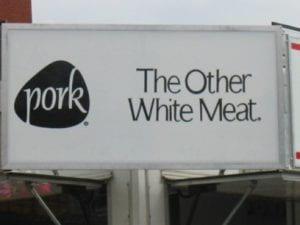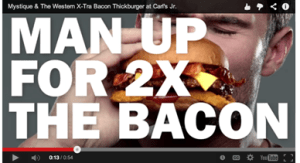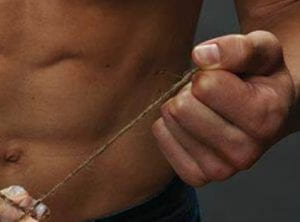Advertising is a pervasive force in our society, and it has the power to influence our beliefs, values, and behaviors. While advertising can be an effective means of promoting products and services, it can also cross the line of decency by exploiting or harming individuals or groups. Unfortunately, marketing fails to consider the ethical implications of advertising and its impact on society, particularly in terms of perpetuating harmful stereotypes, objectifying and sexualizing women and animals, and promoting the consumption of animal products without regard for their welfare.

The billboard featuring the popular slogan “Pork: The other white meat” is a prime example of the kind of messaging that Carol Adams argues contributes to the “war on compassion” towards animals in industrial societies. In her article, The War on Compassion, Adams highlights that “the ‘massification’ of beings is a contributing factor to this phenomenon” (14). As she notes in her book The Sexual Politics of Meat, “mass terms are linked to subjects being diminished [and] in their diminishment, all that is left for them is to become metaphors for others” (Adams 6), allowing for a dilution of our attention and compassion. The advertisement’s focus on the color of pork meat rather than the animal it originated from, reinforces the idea that animals are mere commodities to be consumed without any regard for their emotional or physical wellbeing. This mentality allows for the acceptance of the animals’ suffering, which is necessary for our consumption, and their emotional lives to be ignored.
Moreover, the phrase “the other white meat” used in the ad attempts to rebrand pork as a healthier, leaner alternative to other meats, while conveniently ignoring the negative impacts of industrial animal agriculture on animals and the environment. Marketing campaigns for meat products frequently stress the health benefits of meat consumption, while ignoring the negative environmental and ethical impacts of industrial animal agriculture.
Furthermore, the use of the word “other” in the ad implies that pork is somehow separate from or not as important as other meats, which reinforces the idea and message that “humans use their intelligence, nonhumans are instinctive; humans love, nonhumans mate; humans cultivate friendships, nonhumans have ‘affliative behavior’; humans are humane, cultivated, refined, nonhumans are beasts, brutal” (Dunayer as cited in Adams 2010).

The ad above is an example of the kind of cultural messaging that “contains all that we imagine to be good and powerful on the side of white males”(Kemmerer ). The phrase “man up” used in the ad reinforces the harmful notion that to be a “real man,” one must consume meat and animal products, despite the negative impacts on animals and the environment.
The advertisement reinforces the cultural stereotype that meat consumption is crucial for a robust, manly identity, which further perpetuates this notion. It portrays a man devouring a burger loaded with twice the amount of bacon, further solidifying the belief that animals are merely objects to be consumed, without any consideration for their welfare or emotional experiences. The agricultural industry treats animals as machines, solely producing meat, milk, and eggs for human consumption, disregarding their emotional lives and accepting their physical and psychological pain as necessary. Furthermore, it perpetuates the “war on compassion” towards animals and reinforces harmful cultural stereotypes around meat consumption and masculinity, as outlined by Carol Adams in her article.

Of all the images Adams includes in her book, the ad of a woman in perhaps the most vulnerable position known to mankind, really struck me as the most disrespectful to life, both human and non-human. This ad is a prime example of the way in which the meat industry crosses the line of decency in fostering the objectification and dehumanization of women and animals as a means of promoting the consumption of meat and to sell products.
The advertisement uses a disturbing image of a newborn baby being substituted for a hamburger to convey that food is as essential as a child. The image also presents a disturbing portrayal of women as being mere “consumables,” whose primary purpose is to bear and nurture food for men. As Carol Adams aptly puts it, “Meat is like pornography: before it was someone’s fun, it was someone’s life” (Kemmerer, 1).
The ad further promotes the harmful idea that women’s worth is tied to their ability to satisfy male desires. By portraying the mother’s role as that of a machine that produces offspring, like the mass-producing machines in meat factories, the ad implies that women are merely instruments to serve the needs of others, rather than individuals with their own unique identities.
These harmful gender stereotypes dehumanize women, reducing them to objects to be consumed and perpetuating the troubling view of womanhood presented in the image. The portrayal of women as machines that produce offspring suggests that their bodies exist solely for the purpose of bearing children, reinforcing the idea that they are sexual objects for male pleasure and consumption.
The advertisement is a striking example of how advertisers use subliminal messaging to sell their products by tapping into deep-seated cultural beliefs and stereotypes about women and reinforcing them through provocative imagery.
These depictions perpetuate harmful gender stereotypes and dehumanize women, reducing them to mere objects rather than full human beings with complex identities and experiences. Such imagery has no place in a society that values gender equality and human dignity.

Domination and sexualization go hand in hand, and this image can be interpreted as a representation of male domination over both women and non-human animals. One way in which this domination is depicted is through the portrayal of the man as physically strong and dominant, and the chicken as a passive and submissive being.
Looking closely at the image, it is clear to see that the positioning of the chicken with its bottom lifted off the board and seemingly aligned with the man’s pelvis, adds an additional layer of sexualization and objectification to the scene. This kind of objectification reduces both women and animals to mere objects for male pleasure or convenience, perpetuating harmful gender and species stereotypes that contribute to the domination of certain groups by others.

Additionally, the act of bondage in the image alters the balance of power and can be used as a tool of control. The man’s hand gripping the twine and the tight jerking motion could be interpreted as a demonstration of his control over the chicken.
These two images can contribute to the perception that it is acceptable for men to exert control and power over others and that “animals are inherently passive objects whose only role in life is to serve the human enterprise” (Karen Davis as cited in Adams, 2010).
The objectification of animals in images often fails to acknowledge their inherent value and dignity. Instead, they are portrayed as mere objects for human use, reinforcing the idea that animals are not sentient beings with their own interests and agency. This kind of objectification extends beyond animals and can also be applied to women, who may be similarly treated as objects for male pleasure or conveniences.
It is important to note that the absence of women in certain objectifying images involving animals can lead to people ignoring the harmful gender stereotypes being perpetuated, as some may believe that “because women are not being depicted, no one is seen as being harmed and so no one has to be accountable. Everyone can enjoy the degradation of women without being honest about it” (Adams as cited in Kemmerer, 2003). Here, Adams underscores the danger of objectifying images and messages that contribute to the domination of certain groups by others. The video below is an example of Adams’ theory.
The video below is another example of the degradation of women and sexualization of non-human animals for profit. The trailer is for a cookbook parody of the Fifty Shades of Grey book series by E. L. James.
It is crucial to challenge and reject these kinds of objectifying images and messages to ensure that all living beings, both human and non-human, are treated with respect and dignity. By recognizing the inherent value and agency of animals and women, we can promote a society that values the autonomy and welfare of all living beings.
Works Cited:
Adams, Carol J. “Examples of the Sexual Politics of Meat.” Carol J. Adams, 2018, https://caroljadams.com/examples-of-spom/.
Kemmerer, Lisa. “The Pornography of Meat by Carol Adams.” Philosophy Now, 2006, https://philosophynow.org/issues/56/The_Pornography_of_Meat_by_Carol_Adams.
Potts, Annie, and Carol J. Adams. “The Politics of Carol J. Adams.” Antennae, no. 14, 2010, pp. 12–24., https://static1.squarespace.com/static/54792ff7e4b0674c74cb719d/t/55dc8dace4b0ad76d7277cb7/1440517548517/ANTENNAE+ISSUE+14.pdf. Accessed 3 Mar. 2023.

Hi Rose!
I thought that your blog post this week was engaging and a well written read. I thought that you made an important statement in the opening by saying that advertising can be compelling and successful but within our media-ridden world, there are ruthless, exploitative advertisements that slip onto millions of people’s tv screens or on billboards during one’s commute to work. If we can’t escape the advertising world, we need to look at the impact these sexist, exploitive, and dangerous ads have on the public and create change. I was interested if sex actually sells, therefore I found an article you might find interesting, and I linked it below.
I also found the image of the burger being “birthed” from a woman was also very disturbing and vile. I noticed that it was also a white male as the one “delivering” the burger, looking as if he’s smiling through the mask which I found very unsettling. Taking an act so intimate as giving birth and making a mockery of it made the woman seem more as a prop, or object. It reminded me of the treatment of nonhuman animals in the meat production industry, where they’re looked at as products. A quote I thought of from The Politics of Carol J. Adams by Potts states “female animals are the ones who are the most abused in the production of meat which can only exist because female animals are enslaved reproductively to produce more “meat” for consumers” (Potts 16). In today’s patriarchal society, women are constantly objectified and sexualized, being looked at as “meat”. The feminizing of nonhuman animals and the animalization of women in advertisements make both women and nonhuman animals look like a product instead of conscious, living beings.
https://www.ncbi.nlm.nih.gov/pmc/articles/PMC7890690/
Hi Sam,
It’s disappointing to see that even in modern times, many advertisements continue to depict women as objects of desire rather than autonomous individuals with agency.
The image of the burger being “birthed” bothered me much more than I expected, perhaps because we just welcomed a new baby nephew to our family; nonetheless, the image does reinforce harmful gender stereotypes, which is why it is essential to recognize that the portrayal of women as objects not only perpetuates these stereotypes but also dehumanizes them and contributes to a culture that tolerates violence against them.
The quote you mentioned regarding the feminization of non-human animals and the animalization of women in advertisements is a valid comparison. We must recognize the interconnectedness of oppressive systems that work together to maintain power imbalances, which is why I found the past two units to be very informative as well as enlightening in regard to the exploitation of non-human animals and the objectification of women; both are symptoms of a broader societal problem that requires attention and systemic change.
I appreciate you sharing the article on the effectiveness of sexual content in advertisements. It’s essential to consider the impact of such advertisements on society, particularly in the way women are perceived and treated. I look forward to reading it!
Hi Rose!
Great finds for your photos and videos for this posting!
I am gad that someone else found and used the same photo that I grabbed at when I was assembling my post. I appreciated your interpretation of it because it really threw me when I saw it. This is one of the most offensive and disturbing images I have seen in a while that depict women being subjected to another level of dehumanization where the image displays the women giving birth for a mans pleasure. So not ok!!! Also, when I look at the image again, the man in the photo actually looks like my old high school boyfriend who was, to say the least, not the most kind to women.
Moving forward in your post, I instantly thought about pornography when I saw your photos of the chicken being tied up, and your analysis of how the man was doing it! We all know about the BDSM category in porn, and how it’s almost become an art on how to tie women in such a way that looks ‘sexy’ and put together, so that when they are being filmed, at least they are being ‘cared for’ in a sense I guess while being ‘punished’ in another. The images of the chicken being tied up, is how some women are framed and positioned in porn as to allow for the least amount of resistance to the man. The photo is no different. The act of bondage represents power, and If I am not mistaken is one of the top categories in the porn industry.
I think that it would be really interesting to have a discussion and to hear different opinions around the issue of the objectification of women in the porn industry, when women who are in the business to make money from porn, often do, participate in BDSM pornography. Is it still degrading? Do men care about women’s mental health in porn? Do women support each other in the industry? Are they still looked at as animals? Where do black women come into play in the industry vs white women? Something to think about I think!
Hi Alina,
Thank you for sharing your thoughts and for engaging in a thoughtful discussion about the objectification of women in the porn industry. It is important to remember that BDSM can be a consensual practice between adults, but it can also be used as a way to justify violence and exploitation in the porn industry. The power dynamics involved in BDSM can be similar to those involved in the objectification of women, where men use their dominance to control and exploit women for their own pleasure.
You raised excellent questions you raised about the mental health of women in the porn industry, the support they receive from one another, and the racial dynamics at play. These are all crucial issues that deserve further exploration and discussion. Black women, in particular, have been historically and currently marginalized in the porn industry, and their experiences are often erased or ignored – not surprising since they face the same barriers in all industries. One more reason why it is crucial that we continue to have open and honest discussions about the objectification of women in all forms, including the porn industry.
Hey Rose,
Your post was really insightful and got me thinking. Why don’t we ever discuss what happens to the men who choose to live a vegetarian or vegan lifestyle? They too are seen as lesser than the alpha-male. The Guardian posted an article last year discussing some of the negative connotations around these men. Their choice to pursue a meatless lifestyle has given a bad name to the male dominated society and they have been ridiculed because of it. They are compared to women, called names, assumed gay because eating meat is the most masculine thing they can do and they would just ‘have’ to be a woman if they choose not to.
Here’s the article if you want to read more.
https://www.theguardian.com/lifeandstyle/2022/mar/05/vegan-bros-busting-myth-that-real-men-eat-meat
Hi Lizzy,
Thank you for sharing the article from The Guardian. It’s great to see more awareness being raised about the negative connotations that can be associated with men who choose to follow a vegetarian or vegan lifestyle.
Unfortunately, in some societies, there are still deeply ingrained beliefs that equate meat-eating with masculinity and power. As a result, men who choose to opt-out of this norm can be seen as “less manly” or “feminine.” It’s important to recognize that these stereotypes are not only unfair but also harmful to individuals who are simply making choices about their own diets.
It’s essential to remember that a person’s food choices do not define their gender identity or sexual orientation. All individuals, regardless of gender, should be able to make choices about their diets that align with their personal beliefs and values without fear of ridicule or discrimination.
~ On a side note, it was interesting to read the section of the article that mentions the global greenhouse gas emissions caused by the livestock industry; my son and I were discussing this over the weekend. Thanks again for sharing!